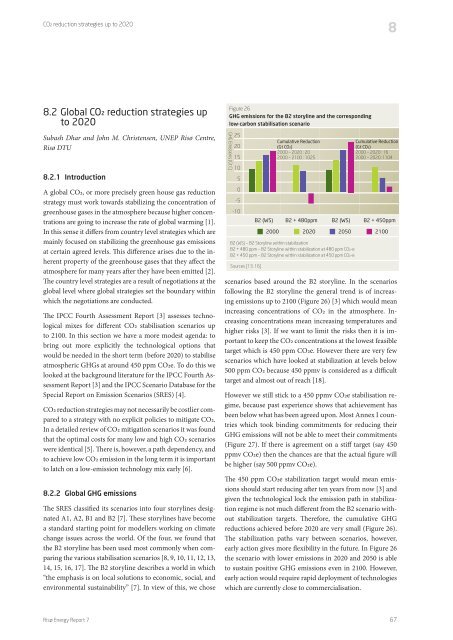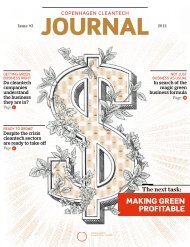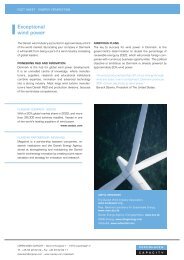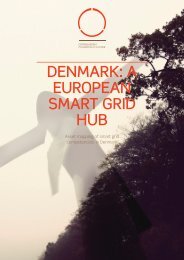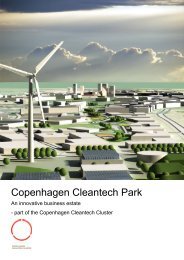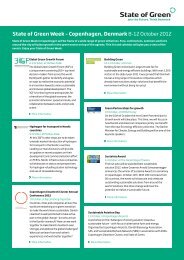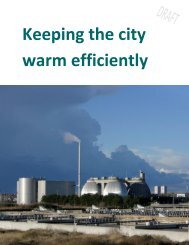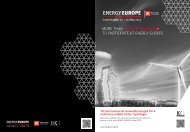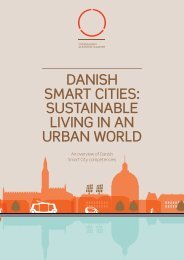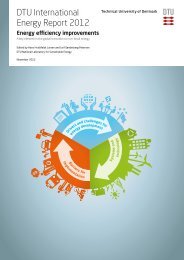Future low carbon energy systems - Copenhagen Cleantech Cluster
Future low carbon energy systems - Copenhagen Cleantech Cluster
Future low carbon energy systems - Copenhagen Cleantech Cluster
Create successful ePaper yourself
Turn your PDF publications into a flip-book with our unique Google optimized e-Paper software.
CO ² reduction strategies up to 202088.2 Global CO ² reduction strategies upto 2020Figure 26GHG emissions for the B2 storyline and the corresponding<strong>low</strong>-<strong>carbon</strong> stabilisation scenarioSubash Dhar and John M. Christensen, UNEP Risø Centre,Risø DTU8.2.1 IntroductionGHG Emissions (Gt C)252015105Cumulative Reduction(Gt CO ² )2000 – 2020 : 202000 – 2100 : 1025Cumulative Reduction(Gt CO ² )2000 – 2020 : 162000 – 2020 :1104A global CO2, or more precisely green house gas reductionstrategy must work towards stabilizing the concentration ofgreenhouse gases in the atmosphere because higher concentrationsare going to increase the rate of global warming [1].In this sense it differs from country level strategies which aremainly focused on stabilizing the greenhouse gas emissionsat certain agreed levels. This difference arises due to the inherentproperty of the greenhouse gases that they affect theatmosphere for many years after they have been emitted [2].The country level strategies are a result of negotiations at theglobal level where global strategies set the boundary withinwhich the negotiations are conducted.The IPCC Fourth Assessment Report [3] assesses technologicalmixes for different CO2 stabilisation scenarios upto 2100. In this section we have a more modest agenda: tobring out more explicitly the technological options thatwould be needed in the short term (before 2020) to stabiliseatmospheric GHGs at around 450 ppm CO2e. To do this welooked at the background literature for the IPCC Fourth AssessmentReport [3] and the IPCC Scenario Database for theSpecial Report on Emission Scenarios (SRES) [4].CO2 reduction strategies may not necessarily be costlier comparedto a strategy with no explicit policies to mitigate CO2.In a detailed review of CO2 mitigation scenarios it was foundthat the optimal costs for many <strong>low</strong> and high CO2 scenarioswere identical [5]. There is, however, a path dependency, andto achieve <strong>low</strong> CO2 emission in the long term it is importantto latch on a <strong>low</strong>-emission technology mix early [6].8.2.2 Global GHG emissionsThe SRES classified its scenarios into four storylines designatedA1, A2, B1 and B2 [7]. These storylines have becomea standard starting point for modellers working on climatechange issues across the world. Of the four, we found thatthe B2 storyline has been used most commonly when comparingthe various stabilisation scenarios [8, 9, 10, 11, 12, 13,14, 15, 16, 17]. The B2 storyline describes a world in which“the emphasis is on local solutions to economic, social, andenvironmental sustainability” [7]. In view of this, we chose0-5-10B2 (WS)B2 (WS) – B2 Storyline within stabilizationB2 + 480 ppm – B2 Storyline within stabilization at 480 ppm CO ² -eB2 + 450 ppm – B2 Storyline within stabilization at 450 ppm CO ² -eSources [13, 16]2000B2 + 480ppm B2 (WS) B2 + 450ppm2020 2050 2100scenarios based around the B2 storyline. In the scenariosfol<strong>low</strong>ing the B2 storyline the general trend is of increasingemissions up to 2100 (Figure 26) [3] which would meanincreasing concentrations of CO2 in the atmosphere. Increasingconcentrations mean increasing temperatures andhigher risks [3]. If we want to limit the risks then it is importantto keep the CO2 concentrations at the <strong>low</strong>est feasibletarget which is 450 ppm CO2e. However there are very fewscenarios which have looked at stabilization at levels be<strong>low</strong>500 ppm CO2 because 450 ppmv is considered as a difficulttarget and almost out of reach [18].However we still stick to a 450 ppmv CO2e stabilisation regime,because past experience shows that achievement hasbeen be<strong>low</strong> what has been agreed upon. Most Annex I countrieswhich took binding commitments for reducing theirGHG emissions will not be able to meet their commitments(Figure 27). If there is agreement on a stiff target (say 450ppmv CO2e) then the chances are that the actual figure willbe higher (say 500 ppmv CO2e).The 450 ppm CO2e stabilization target would mean emissionsshould start reducing after ten years from now [3] andgiven the technological lock the emission path in stabilizationregime is not much different from the B2 scenario withoutstabilization targets. Therefore, the cumulative GHGreductions achieved before 2020 are very small (Figure 26).The stabilization paths vary between scenarios, however,early action gives more flexibility in the future. In Figure 26the scenario with <strong>low</strong>er emissions in 2020 and 2050 is ableto sustain positive GHG emissions even in 2100. However,early action would require rapid deployment of technologieswhich are currently close to commercialisation.Risø Energy Report 767


